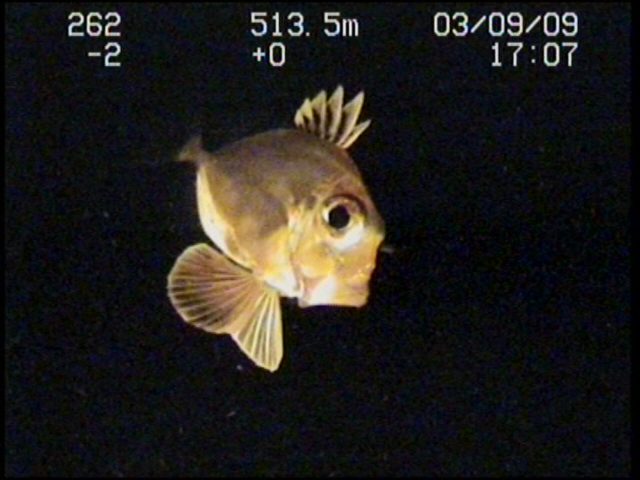Overview
The deep-sea starts at 200 m below the surface, where sunlight does not penetrate – but where fisheries still operate, reaching down to more than 1500 m. Most deep-sea fisheries in the North-East Atlantic sprang up in the second half of the 20th century, after the decline of traditional continental shelf stocks, and with the aid of new technologies . These fisheries target some commonly consumed fish, such as red seabream (Pagellus bogaraveo) and black scabbardfish (Aphanopus carbo).
Species living at these depths have adapted to a cold, dark environment, with few nutrients. As a consequence, they are characterised by slow growth rates, late sexual maturity, few offspring and long lifespans. This makes them highly vulnerable to overfishing, because their capacity to recover from depletion is very limited.
Deep-sea rays and sharks are among the most vulnerable species, since once a stock is depleted, its recovery may take centuries. For example, the gulper shark (Centrophorus granulosus) and birdbeak dogfish (Deania calcea), which are both captured by the EU fleet, take around 55 and 49 years, respectively, for their populations to double in size. Deep-sea sharks in the region have been heavily targeted for their livers, which contain squalene used to produce cosmetics and Omega-3 acid dietary supplements. Due to severe declines in several of the most heavily fished species, 17 species of deep-sea sharks can no longer be kept, landed,
Deep-sea life takes refuge in fragile ecosystems such as coral reefs, sponge beds or hydrothermal vents which represent important sources of biodiversity. The United Nations consider these features as Vulnerable Marine Ecosystems (VMEs) and calls for their protection against the damaging impacts of bottom fishing gears such as trawl nets, which can damage or destroy everything that lies in their path.
The EU began to manage deep-sea stocks in 2002, but Regulation (EC) 2347/2002 (the ‘deep-sea access regime’) has failed to ensure their sustainable management. Few species are managed with catch limits (total allowable catches or TACs), and these TACs have frequently been set higher than scientifically advised. Even so, in about 50% of cases, actual catches have exceeded the agreed TACs. Many captured species are not included at all in the regulation and therefore are completely unmanaged, and can be caught in unlimited quantities. The regulation also places no restrictions on destructive fishing gears (i.e., deep-sea bottom trawls and gillnets), leaves ecosystems unprotected from damaging bottom gears, and fails to reflect international commitments made by the EU through United Nations General Assembly (UNGA) Resolutions 61/105 and 64/72, which call upon flag states to implement conservation and management measures to protect vulnerable marine ecosystems (VMEs).
The European Commission tabled a proposal for a new regulation in 2012, which aims to ensure sustainable exploitation of deep-sea fisheries, to minimise environmental impacts, and to improve scientific knowledge about these resources and habitats. This proposal also included the phase-out of destructive, non-selective fishing gears for targeting deep-sea species, because of the direct physical damage they cause to VMEs and high associated levels of by-catch.
During 2013, the issue was debated in the European Parliament. In December 2013, the Parliament adopted its position, which includes a broad package of measures to improve the management and conservation of deep-sea species and ecosystems. Unfortunately, due to human error (a mistake as simple as pushing the wrong voting button), the ban on destructive, non-selective gear was voted down by a difference of only 16 votes.
Currently, the file is being discussed within the Council of Fisheries Ministers, which must now decide its own position. During this process, Oceana is holding ongoing meetings with decision-makers, calling for measures that include:
- Stronger protection of deep-sea sharks, including all gulper sharks (Centrophorus spp.)
- A clear, loophole-free definition of ‘targeted deep-sea fishing’.
- Fishing levels set using catch limits, strictly following scientific advice, and considering impacts on non-target species.
- Closure of areas with VMEs (e.g., deep-sea coral reefs and sponge beds) to bottom fishing.
- Environmental impact assessments in both new and existing fishing areas before authorising deep-sea fishing.
- Measures to prevent overfishing, excess fishing capacity, by-catch, discards, and illegal fishing in all deep-sea fisheries.
- The phase-out of destructive, non-selective fishing gears (i.e., deep-sea bottom trawls and bottom-set gillnets) for targeting deep-sea species.
- Vessel authorisations should be strictly conditional upon cooperation with scientific data collection.


